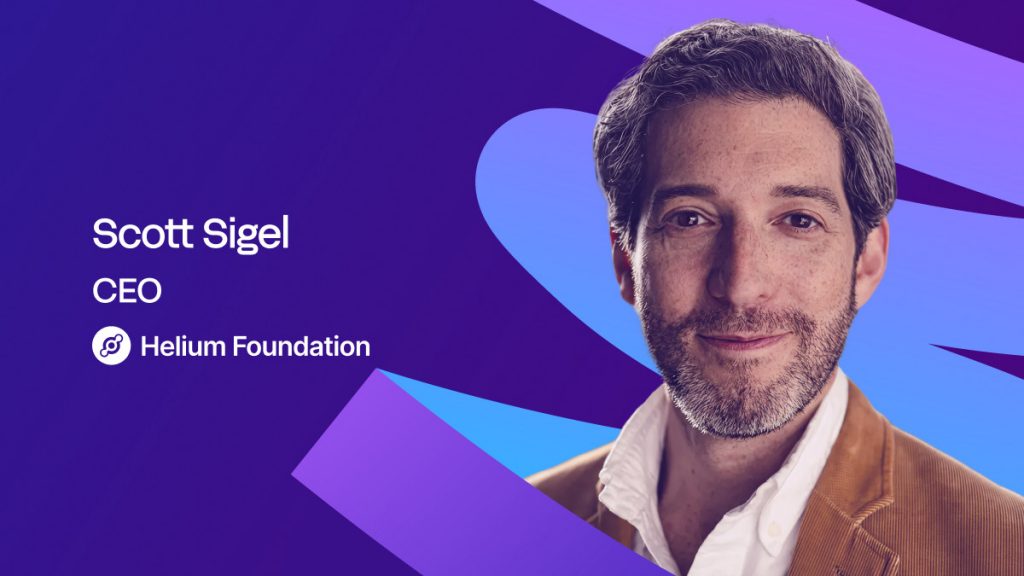Helium: the People-Powered Future of Global Connectivity is Here


In Brief
Helium is redefining telecom with a people-powered wireless network serving nearly two million users daily and partnering with giants like Telefónica and AT&T to make connectivity more affordable and decentralized through crypto incentives.

The Helium Network already serves nearly two million people every day, a number that’s growing as the network continues to expand. In this interview, Helium Foundation CEO Scott Sigel explains how the project is redefining telecom with a people-powered wireless network that’s already partnered with major carriers like Telefónica and AT&T, using crypto incentives to make connectivity more available, affordable, and decentralized than ever before.
Scott, could you please introduce yourself and share your path to Web3?
Happy to, and thanks for having me! I’m Scott Sigel, CEO of the Helium Foundation. I’ve been on the foundation side of the project for about five years, focusing on developing and expanding the Network as an offload solution for major telecoms and improving global wireless infrastructure. Before Helium, I worked on several projects, including short-term collaborations with the Arweave and Solana teams.
Before that, I worked with a team of cryptographers focused on cross-chain trustless settlement back when exchange hacks were the biggest issue in crypto. This was right before DeFi really emerged. Before that, most of my career was in traditional venture scaling consumer tech and fintech businesses for over a decade.
What is Helium’s current strategy for expanding its decentralized wireless network globally?
First, it’s important to understand why Helium really matters. Helium is rebuilding connectivity, and we’re leading the wireless revolution with HNT. The traditional wireless industry is over 100 years old and still operates in a highly centralized, capital-intensive way. Large mobile network operators spend billions every year maintaining towers and wireless radios, while users see rising bills, stagnant or declining coverage, and very little innovation. Helium is flipping that model by creating a more adaptable, community-driven network that anyone can participate in and own a piece of.
Our expansion strategy has three main focuses. First, improving indoor coverage, which is a major weakness of traditional networks. Macro towers tend to be optimized for outdoor use, leading to dropped calls and data issues indoors. We’re targeting high-demand environments like airports, shopping malls, and arenas.
Second, we’re converting existing Wi-Fi access points into Helium-compatible infrastructure. This makes connecting easier for users, with no passwords and no friction, and it scales our network quickly. Third, we’re partnering with international carriers that want to improve their coverage footprint and lower costs. These partnerships allow us to convert existing infrastructure while incentivizing coverage growth through Helium’s model.
How does Helium view competition from traditional 5G carriers and other decentralized networks?
Traditional operators rely on significant capital expenditure and centralized infrastructure, which makes them less adaptable. Helium’s model, based on incentivized coverage, is far more adaptable and inclusive; anyone can participate and own part of the network with HNT. Helium lets individuals and businesses deploy coverage, earn rewards, and solve local connectivity issues in real time.
In terms of decentralized competitors, Helium stands out because we operate our own carrier. Users can subscribe directly to Helium Mobile and immediately experience the network. Another big differentiator is our focus on “quality of service” metrics. We provide granular data on access points, signal strength, user connections, and data throughput, which traditional carriers often lack. This metadata gives network operators unprecedented insight and is something we’re standardizing in collaboration with the WBA (Wireless Broadband Alliance).
What are the technical differences between Helium mobile hotspots and converted Wi-Fi networks?
The main difference lies in cost and flexibility. Deploying Helium coverage is far cheaper, and our hotspots are highly adaptable. They also offer enhanced quality-of-service metrics through firmware that provides detailed network data, something traditional hardware typically can’t. Helium hotspots are ideal for small business owners or communities that want to close gaps in coverage quickly and cost-effectively.
What are Helium’s biggest challenges in onboarding new service providers and subscribers?
Early on, the challenge was proving that a people-powered network could match the reliability of traditional service providers. We’ve since demonstrated that it can, and the proof is in the millions of daily users. For subscribers, it’s traditional consumer challenges: getting attention, onboarding users, and providing enough value to retain customers. One unique advantage we have, though, is our ability to offer a free mobile phone plan.
Another success metric is the steady decline in roaming costs per user. Helium Mobile subscribers use the Helium Network when it’s available, but they roam on T-Mobile’s network in the U.S.. Month after month, the share of traffic on Helium’s network increases, driving down overall costs and improving profitability for our eponymous carrier.
What partnerships or collaborations is Helium pursuing to accelerate mobile network adoption?
We’re in an exciting phase of global collaboration. Beyond the U.S., we’re working with operators in the U.K., South America, and Southeast Asia to expand their footprint using Helium’s model. One notable example is Telefónica, which is an active partner and is launching paid data to Helium deployers in Mexico. These partnerships show that established carriers see Helium as a way to reduce costs and improve scalability across their networks.
What are the main regulatory challenges for decentralized wireless networks globally?
We’ve moved past many of the early regulatory hurdles. Helium is very active in Washington, D.C., helping define token utility and hardware classification for decentralized physical infrastructure networks. We’re seen as a nonpartisan project by policymakers because of our practical utility. While the U.S. government slowdown has delayed some progress, the overall engagement has been positive.
Wireless and radio regulations already exist under various bodies, so our main focus has been clarifying the crypto market structure, where we’ve taken a leadership role. We’re also collaborating with public agencies exploring Helium’s use for emergency services and disaster response, which is incredibly encouraging.
How will blockchain integration transform mobile network infrastructure in the next 5–10 years?
We’re already seeing that transformation. Tokenized incentives are the reason people can collectively build these massive physical networks. Going forward, blockchain will enable dynamic data pricing, similar to Uber’s surge pricing model, where data costs fluctuate in real time based on demand. For instance, during a major event, data could be repriced dynamically while remaining invisible to users.
It also unlocks revenue-sharing and DeFi integration. Network assets like Helium hotspots generate predictable cash flow, which can serve as collateral for borrowing or liquidity in DeFi markets. This bridges DePIN and DeFi in powerful new ways.
What trends in IoT and smart city deployments create the most demand for Helium’s LoRaWAN network?
We’ve seen tremendous adoption in smart city use cases like flood detection, air quality monitoring, construction safety, and asset tracking. IoT has long been fragmented, but the demand for reliable, low-data connectivity is growing fast. Looking ahead, new applications, robotics, AI for mobility, public safety, and emergency response, require dense, redundant coverage. Helium’s deployments for mobile users naturally benefit these emerging smart city needs.
How does Helium envision the future of decentralized telecom, and what role will it play in bridging underserved areas?
Decentralized telecom represents an entirely new connectivity economy. Helium empowers small business owners and local providers to deploy and manage coverage, complementing major carriers like Verizon or Vodafone. We see the future as a hybrid model, carrier-built infrastructure plus community-built networks for dense indoor coverage, arenas, shopping centers, rural areas, and underserved regions.
This bottom-up approach makes capital use far more efficient, even when supported by public grants or NGO funding. The global telecom market is enormous, and even capturing 1–2% of it would be transformative. The growing number of enterprise users and carrier partnerships shows that decentralized wireless is solving real-world demand right now.
Finally, could you share Helium’s roadmap and any upcoming features?
We’re focused on scaling what’s already working. The model is validated, demand is strong, and commercial viability continues to improve. Helium Mobile now has nearly half a million sign-ups and serves close to 2 million daily active users, including roaming traffic. Our priority is expanding coverage, strengthening partnerships, and entering new markets, particularly in South America, Southeast Asia, and Europe.
At this stage, it’s less about flashy new technical features and more about sustainable, global expansion. The inbound interest from international carriers and large venues reinforces that Helium is the connectivity infrastructure for the 21st century and beyond.
Disclaimer
In line with the Trust Project guidelines, please note that the information provided on this page is not intended to be and should not be interpreted as legal, tax, investment, financial, or any other form of advice. It is important to only invest what you can afford to lose and to seek independent financial advice if you have any doubts. For further information, we suggest referring to the terms and conditions as well as the help and support pages provided by the issuer or advertiser. MetaversePost is committed to accurate, unbiased reporting, but market conditions are subject to change without notice.
About The Author
Victoria is a writer on a variety of technology topics including Web3.0, AI and cryptocurrencies. Her extensive experience allows her to write insightful articles for the wider audience.
More articles

Victoria is a writer on a variety of technology topics including Web3.0, AI and cryptocurrencies. Her extensive experience allows her to write insightful articles for the wider audience.

















































